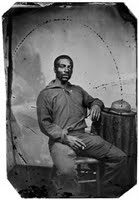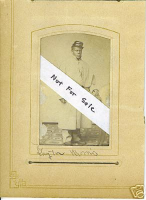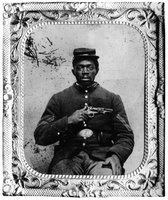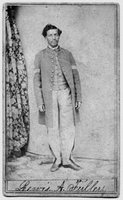Sarah's Story

On March 14, 1900, Sarah Commodore appeared at the federal pension office in Baltimore and was interviewed by a special examiner regarding her recent application for widow's benefits. Her husband, George William Commodore (right) served as a landsman in the navy from 1864 to 1867. Sarah told the examiner about her marriage and life after his death. Her four-page testimony is preserved in her pension file (with his tintype) at the National Archives in Washington, D.C.
Here is the transcript of her statement. The original is one long paragraph. I divided this transcript into paragraphs, inserting breaks where it appears the special examiner asked a question. The line of questions is based upon a preliminary investigation in 1899 and a review of Commodore's service record.
I am about 65 years of age but cannot state positively. My post office address is 1623 Brunt St. Balt. Md. & a laundress. I am the widow of George W. Commodore who served in the U.S. Navy during the Civil War. I cannot say when he enlisted or was discharged. I think he enlisted early in the war. He served for three years. He enlisted at Baltimore and a few days afterward I visited him in the ship he was on. I think it was called the “Allegheny.” I did not see my husband again until he was stationed at the Washington Navy Yard & I then visited him often. He was not then on a vessel but was a cook on shore in the Navy Yard.
The picture that I now show you was taken at Washington, I think, while he was there in the Navy Yard. I know that he sent it from there to me & I have kept it ever since.
The enlistment I have stated was the only time he was in the Navy & he was never in the Army or in any other service. I am sure he enlisted under his own name which was George William Commodore.
My husband died in April and I think 15 years ago. A society he belonged to gave me a lot at the time of his death & my husband is buried in that lot. I show you the deed. (She owns that lot 385. B. Sharp St. Cemetery, Balt. Was deeded by the Trustees of said Cemetery to Sarah Commodore on Apl. 23, 1885. The deed is signed by the Pres. & Sec. with seal embossed. M.A.W. Spl. Ex.).
I was married several years before the war but cannot give the date or even approximate. I had a certificate but lost it years ago & failed to have it renewed. I was married to sailor Geo. W. Commodore by Rev. Savage Hammond a minister of the A.M.E. Church, & was pastor of the Bethel Church Baltimore. I was married at the house of a cousin of mine, Mrs. Susan Golden who lived on Little Monument St. bet. St. Mary and Orchard St. Mrs. Golden is dead. Georgiana Jefferson was my bridesmaid. She is now Georgiana Clayton & is still living. Mrs. Harris was also present when I was married and she is now dead. Rev. Hammond died years ago, either during the war or soon afterward, in Baltimore. I do not recall any one except Mrs. Clayton who was present when I was married & who are now living.
My maiden name was Sarah Jones. Both my husband & myself were raised in Baltimore and both were freeborn. We were boy & girl together & I had known my husband for six or more years before we were married. He was about 3 years older than I was. I have not remarried since my husbands death but am still his legal widow. Neither my husband nor myself have been married before our marriage to each other. We were never separated but lived together for about 40 years & he was with me & I nursed him during his last illness & until his death.
We then lived on St. Mary St., had half a house with a man named Pearce & my husband died there of heart disease. We had 7 children but all are dead. The last child died about 7 years since. But one was living when my husband died & she was married at that time.
I do not know my husbands age when he enlisted. Cannot say whether he was 39 or 40 or what, but my oldest living child was about 8 years old when her father enlisted & she was my fifth child then being 4 children older but who were dead at that time.
My husband had no marks or scars of any kind that I remember. My husband never had small pox since I first new him. He has said that when young he had small pox but he had no marks of such so far as I ever saw or knew of.
He was a dragman when he enlisted. He was short in height, not very stout, was dark in complexion, hair & eyes. He wore his mustache as shown in likeness when he went away to enlist, if I recollect correctly. My husband was at the Washington Navy Yard most of his time. I think he only served on vessels for a few months not a year altogether.
So far as I know or heard my husband had good health while in the service. Never knew or heard of him being sick at any time until after the war, when he first had trouble with his heart.
Soon after my husband left the Navy he bought a little piece of land across the river from Washington, in Maryland, & his mother & sister went there to live. We never received any benefit from it and after his mother & sister died I do not know what became of it. We never attended to it or paid taxes on it & never visited it. After my husband died I just let it be as before & have never paid taxes on it. I can’t say what it cost but my recollection is that my husband paid about $80.00 for it. He did not own any other property. He had no life insurance. He belonged to the Odd Fellows & they buried him & gave me the lot. I have never received any other benefits from any society or in any way, and have never had any income of any kind except from my own labor.
My daughter could not help me for she had to work for her children, for her husband did not help her. After her death I have had to take care of my daughters children, & I have them still with me. The two eldest help me a little & the two youngest are at school. The eldest is nearly 19.
After my husbands death I went out to service, first with Mr. Arthur Palmer with whom I worked 11 months. I then went to Bishop Paret & served there 4 years. Then my daughter died & I had to take care of her children, so rented two rooms & have had them with me ever since supporting myself & them, by washing & other work that I can get to do.
My husband did not apply for a pension during his life time. He had good health & so have I & we get along comfortably so did not think we were entitled. He was only sick about a year before he died. After his death I did not apply for a pension because I had lost my marriage certificate & my husbands discharge. Lately I was told by a friend that I could get a pension under another law, & would not need the papers I had lost, so I put in a application as I was greatly in need of help & was getting old. I do not know who I can furnish to prove that my husband or myself were not married before our marriage, except Mrs. Clayton. I know that Richard Owens and Maria Johnson both knew me when I was young and since but I don’t know where they live. Sarah Chambers also knew me.
I will be present here if I can when my witnesses are examined by my attorney. Mr. A. Parleff Lloyd is prosecuting my claim. I have made no arrangement with him as to fee, and have never paid him any fees. My statement has been read to me, I have understood your questions & am correctly recorded.
Witness: N.N. Hill
Sarah (her X mark) Commodore
Deponent
Labels: african american, baltimore, civil war, d.c., george william commodore, history, maryland, military, national archives, navy, pension, photograph, sarah commodore, tintype, washington, widow





